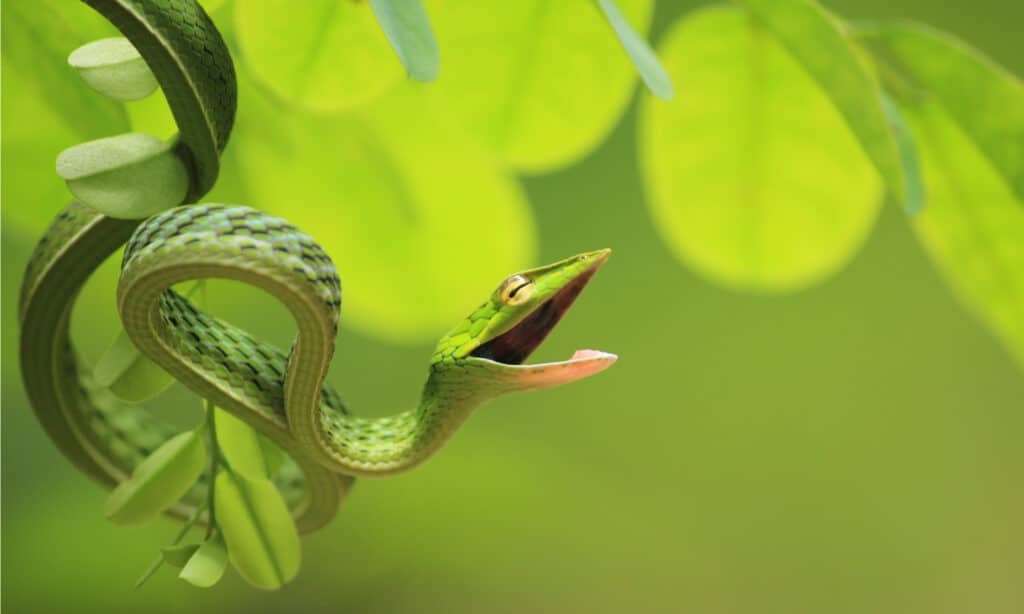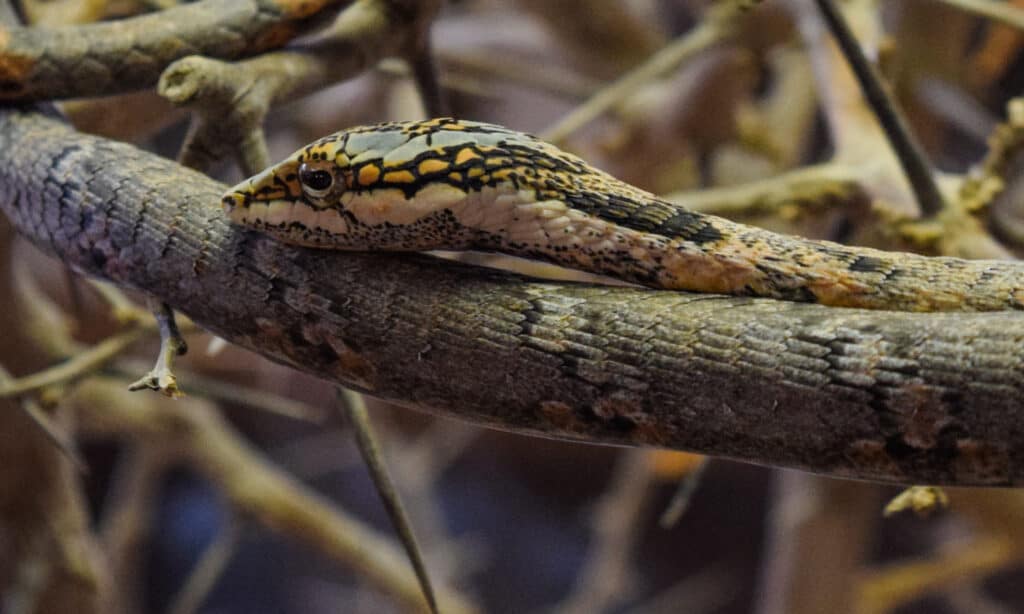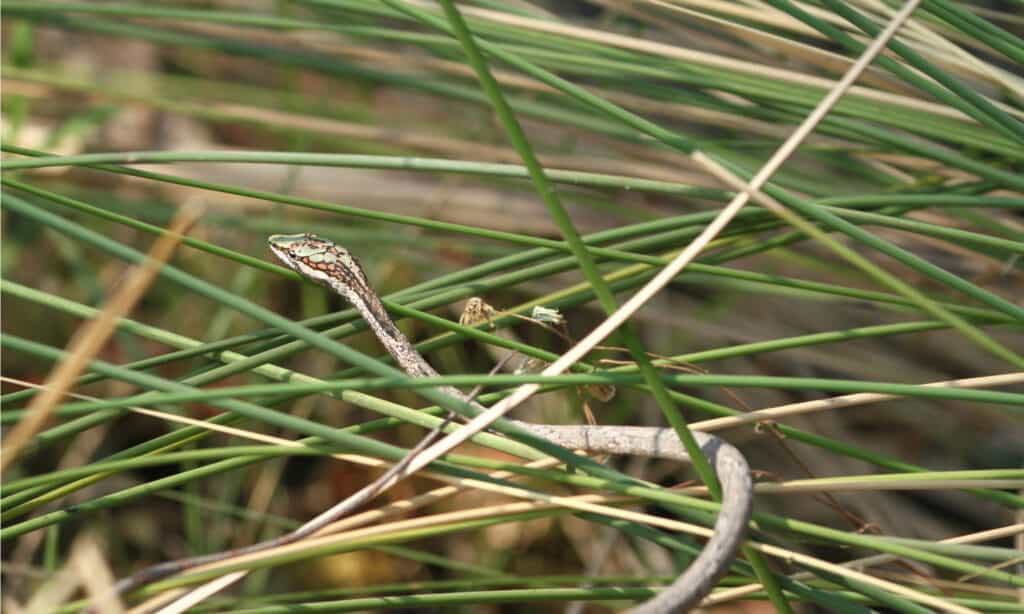Vine Snake
.jumbotron {
background-image: url(“https://a-z-animals.com/media/2022/04/Vine-Snake-header-400×300.jpg”);
}
}
@media only screen and (min-width: 641px) and (max-width: 920px) {
.jumbotron {
background-image: url(“https://a-z-animals.com/media/2022/04/Vine-Snake-header-470×370.jpg”);
}
}
@media only screen and (min-width: 921px) {
.jumbotron {
background-image: url(“https://a-z-animals.com/media/2022/04/Vine-Snake-header.jpg”);
}
}
Vine Snake
A slender body and elongated snout give the vine snake a regal look.
Vine Snake Scientific Classification
Read our Complete Guide to Classification of Animals.
Vine Snake Conservation Status
Vine Snake Facts
- Prey
- Small amphibians and reptiles
- Fun Fact
- A slender body and elongated snout give the vine snake a regal look.
- Litter Size
- 6-10
Vine Snake Physical Characteristics
- Color
-
- Brown
- Yellow
- Green
- Skin Type
- Scales
- Lifespan
- Up to 15 years
- Venomous
- Yes
- Aggression
- Medium
This post may contain affiliate links to our partners like Chewy, Amazon, and others. Purchasing through these helps us further the A-Z Animals mission to educate about the world’s species..

Discover alligator-eating snakes, spiders larger than your phone, and 1000 more incredible animals in our daily FREE email.
.photo-gallery {
–margin: 0px auto 0px;
–padding: 0px 0px 0px 0px;
}
.gallery-link {
background-image: url(“https://a-z-animals.com/media/2022/04/Vine-Snake-header-1024×614.jpg”);
background-repeat: no-repeat;
background-size: cover;
background-position: center;
height: 500px;
justify-content: center;
text-align: center;
align-items: center;
display: flex;
border: 2px solid #000;
}
.gallery-link img {
height: 50%;
}
@media only screen and (max-width: 768px) {
.gallery-link {
height: 300px !important;
}
}
View all of the Vine Snake images!
A slender body and elongated snout give the vine snake a regal look.
The vine snake is found in Asia, Africa, and the Americas. While all species of the vine snake have some form of venom they use on their prey, only the twig snake of Africa is harmful to humans. Bites from other species will, at most, cause irritation or, in some cases, an allergic reaction.
Despite the differences between the different species of vine snakes, they all rely on similar traits when hunting. They hunt by ambush and use their natural camouflage to their advantage. Venomous fangs allow them to take down frogs, lizards, and birds.
button.pulse {
transform: scale(1); animation: pulse 2s infinite;
box-shadow: 0 0 0 0 rgba(11, 247, 25, 1);
}
@keyframes pulse {
0% { transform: scale(0.90); box-shadow: 0 0 0 0 rgba(11, 247, 25, 0.5); }
60% { transform: scale(1); box-shadow: 0 0 0 15px rgba(11, 247, 25, 0); }
100% { transform: scale(0.90); box-shadow: 0 0 0 0 rgba(11, 247, 25, 0); }
}
Three Vine Snake Amazing Facts!
- The Sri Lankan vine snake appears green, but when threatened, will expand, displaying a black and white scale pattern.
- The African vine snake, also known as the twig snake, has a deadly bite, but due to the construction of its mouth, it can only latch on to a few parts of the human body, such as the webbing between the thumb and fingers.
- The vine snake has unique fangs. Rather than the venom being dispersed through the fang itself, grooves along the outside of the fang allow the venom to drip down as the snake chews.
Where to Find Vine Snakes
The vine snake can be found in many areas around the world. Different species are located in Africa, Asia, Mexico, Central America, Northern South America, and the Southwestern United States.
The brown species of vine snakes, such as the Savanna vine snake, typically live in dry forests and savannas. The green species, such as the Sri Lankan green vine snake, typically live in rainforest areas.
Vine Snake Scientific Name
The vine snake is the name given to any of the species of snakes in the family Colubridae. They include Ahaetulla which are Asiatic vine snakes, such as the Sri Lankan green vine snake, and Chironius, which has 23 species. Imantodes are recognizable by their blunt heads, and Oxybelis is the genus found in the Americas. Finally, Thelotornis is the genus that has a bite that is deadly to humans.
Vine Snake Population & Conservation Status
The population size of the vine snake is unknown. It is well-established and it is considered a species of least concern. The exception to this is Chironius vinventi which is considered critically endangered.
How to Identify the Vine Snake: Appearance and Description
There are many common vine snakes, and their coloring can be bright green, brown, or something in between. The easiest way to distinguish these snakes is by their narrow heads with an elongated, pointed snouts. They also have very slender bodies. Regardless of length, they are rarely wider than a penny.
Their narrow bodies mean that, when kept as a pet, they must be handled cautiously. They are delicate, and, if they escape, can easily become injured when recaptured.
Read about the largest vine snake ever found.
Vine Snake Pictures

Nikhil patil 0321/Shutterstock.com

Authentic travel/Shutterstock.com

Anders Stoustrup/Shutterstock.com
Vine Snake Venom: How Dangerous Are They?
The twig snake, an African genus of vine snake, is very dangerous. Its venom creates clotting problems in the blood. Someone bitten by one of these snakes may bleed to death.
There are four species of the genus Thelotornis. They are all African snakes and can be found in the savanna (Savanna vine snake), the jungle (forest vine snake), Eastern Africa (Eastern vine snake), and along the coast (Usambara vine snake).
Vine Snake Behavior and Humans
Most of the common vine snakes are not aggressive, however, they are solitary. If they are cornered or feel threatened, they may strike. The design of their fangs, toward the back of the mouth, and with grooves that allow the venom to drip down, mean that the snake needs to chew, rather than just bite, to inject venom.
View all 14 animals that start with V
Vine Snake FAQs (Frequently Asked Questions)
Is the vine snake poisonous?
Bites from most species of the vine snake are not deadly. Some may cause a mild reaction. The bites of the Thelotornis, or twig snakes, have caused fatalities in humans.
A few of the other genera of vine snakes, such as Ahaetulla are mildly poisonous to humans. The placement of the vine snake’s fangs makes venomous bites rare, even from the dangerous twig snake. Located in the back of the upper jaw, the fangs are designed to inject venom as the snake chews, rather than when striking.
How do vine snakes hunt?
They are ambush predators. They lay perfectly still until prey gets within range, then strike with lightning-quick speed.
Are vine snakes aggressive?
Not typically, although they don’t generally like being handled. If they are feeling threatened, they will puff out their neck and hold their body in the shape of an “S”.
Where do vine snakes live?
Africa, Asia, Mexico, Central America, Northern South America, and the Southwestern United States.
What do vine snakes eat?
Small reptiles and amphibians.
What happens when a vine snake bites you?
The bite of the twig snake, the most poisonous vine snake, is hemotoxic. This means that it affects the body’s ability to control bleeding. Illness and death may result from internal hemorrhaging and uncontrolled breathing.
Can a vine snake be a pet?
The Asian vine snake is often kept as a pet by experienced snake owners. They have some very specific needs to remain healthy, such as a humidity of between 75 and 90 percent and finicky diet needs.
Is the Philippine vine snake venomous?
It is venomous, but the venom is weak and generally doesn’t cause issues for humans.
Sources
- Loveland Living Planet Aquarium, Available here: https://thelivingplanet.com/animal/asian-vine-snake/
- Britannica, Available here: https://www.britannica.com/animal/vine-snake
- Animalia, Available here: https://animalia.bio/green-vine-snake
















